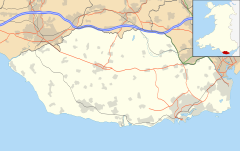Sutton is a small hamlet in the Vale of Glamorgan, just south of Llandow.
| Sutton | |
|---|---|
 Springfield Nurseries | |
Location within the Vale of Glamorgan | |
| Principal area | |
| Preserved county | |
| Country | Wales |
| Sovereign state | United Kingdom |
| Post town | COWBRIDGE |
| Postcode district | CF71 |
| Police | South Wales |
| Fire | South Wales |
| Ambulance | Welsh |
| UK Parliament | |
| Senedd Cymru – Welsh Parliament | |
History
editSutton was once home to the Turbervill family, and Edward Turbervill once had his seat at Sutton.[1] A Bronze Age barrow has been unearthed in Sutton.[2][3] In 1940, Sir Cyril Fox was said to have found "a primary burial of a typical Beaker man, crouched in a large pit cut into the subsoil, with a Beaker of debased 'B1' type and barbed and tanged flint arrow-heads."[4]
Notable landmarks
editIt contains three listed buildings, Sutton Farmhouse which is Grade II* listed and the "Long Range of Outbuildings to Northwest of Sutton Farmhouse" and "Small Outbuilding immediately to West of Sutton Farmhouse" which are Grade II listed.[5] Nearby is Llandow Industrial Estate and Springfield Nurseries, a major supplier of pot Chrysanthemums to the UK market.
A 5 bedroom mansion in Sutton named The Granary was valued at £730,000 as of August 2011, making it amongst the most expensive properties in the county.[6]
References
edit- ^ A List of the names and residences of the High Sheriffs of the County of Glamorgan: from 1541 to 1966. George Williams. 1966. p. 84. Retrieved 20 August 2011.
- ^ The bulletin of the Board of Celtic Studies. Oxford University Press. 1968. p. 283. Retrieved 20 August 2011.
- ^ National Museum of Wales (1939). Annual report. The Museum. Retrieved 20 August 2011.
- ^ Foster, Idris Llewelyn; Daniel, Glyn Edmund (1965). Prehistoric and early Wales. Routledge and K. Paul. p. 83. Retrieved 20 August 2011.
- ^ "Listed Buildings" (PDF). www.valeofglamorgan.gov.uk. Retrieved 20 August 2011.
- ^ "The Granary". Zoopla. Retrieved 20 August 2010.
